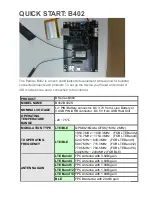
- 12 -
VIII. System Troubleshooting
The majority of charging difficulties can be attributed to damage, corrosion or wear at wires or wiring connec-
tions. Before attempting to troubleshoot alternator or regulator issues, be sure to address the following:
1.
Remove and clean all charging system electrical connections (positive and negative). Check the voltage regulator’s
harness for resistance. Wires and terminals can and will become corroded, and need to be cleaned or replaced.
2.
Charge all batteries to their proper fully charged state, and determine if they are serviceable. If your batteries are
flooded-type, use your hydrometer to determine their condition.
3.
Check and tighten alternator belt. If the belt show signs of wear or damage, replace it. Always replace existing belts
with the finest quality replacements available.
If batteries and wiring are in suitable condition, use the following tests to determine if charging problems are
a result of a faulty alternator or regulator. These tests provide an opportunity to isolate the alternator, regula-
tor and wiring harness in order to determine which component may be malfunctioning. In order to perform
these tests, you will need an independent DC meter (preferably a digital type). In an emergency, a 12V light
bulb or test light can be used to help determine if power or working grounds exist. An amp meter and a battery
hydrometer with a thermometer are also helpful diagnostic tools.
A. Voltage Regulator Test
Set your voltmeter to 12VDC and connect the negative lead to the
BLACK ground wire at the regulator as shown at right
.
1.
With the ignition OFF, check voltage on the red (sensing), blue (field) and
brown (ignition) wires in the regulator plug.
2.
With the ignition in the ON position (engine not running), check for volt-
age on the red (sensing), blue (field) and brown (ignition) wires. The volt-
meter should read:
3.
With the ignition in the ON position (with engine running at 1,400 rpm fast
idle), check for voltage on the red (sensing), blue (field) and brown (igni-
tion) wires in the regulator plug.
Compare your readings with the table at right. If readings on RED or
BROWN wires do not match values shown, check 10-amp and 1-amp
fuses, wiring and connections back to their sources. If RED and BROWN
match expected readings, but BLUE does not, unplug and re-plug
four-prong plug and re-test. If the BLUE wire shows zero voltage
and the display is not lit, check connections and fusing on the
Positive Battery Sense wire. Check voltage at the base of the
Positive Battery Sense terminal with your meter.
If voltage is not present on the RED, the BROWN and the Positive
Battery Sense Wire, the regulator will not work. If voltage is as
expected at the RED the BROWN and Positive Battery Sense
wire, and there is zero, or an unexpected voltage reading at the
BLUE wire, contact our technical support staff at (360) 435-6100,
or e-mail us at [email protected].
If all voltages at the regulator meet expectations, yet the alterna-
tor is not producing charging current, we will want to test the
alternator. The tests on the following page are recommended for
determining alternator functionality.
Red/Black
Brown/Black
Blue/Black
Summary of Contents for Max Charge MC-612
Page 15: ...15...



































